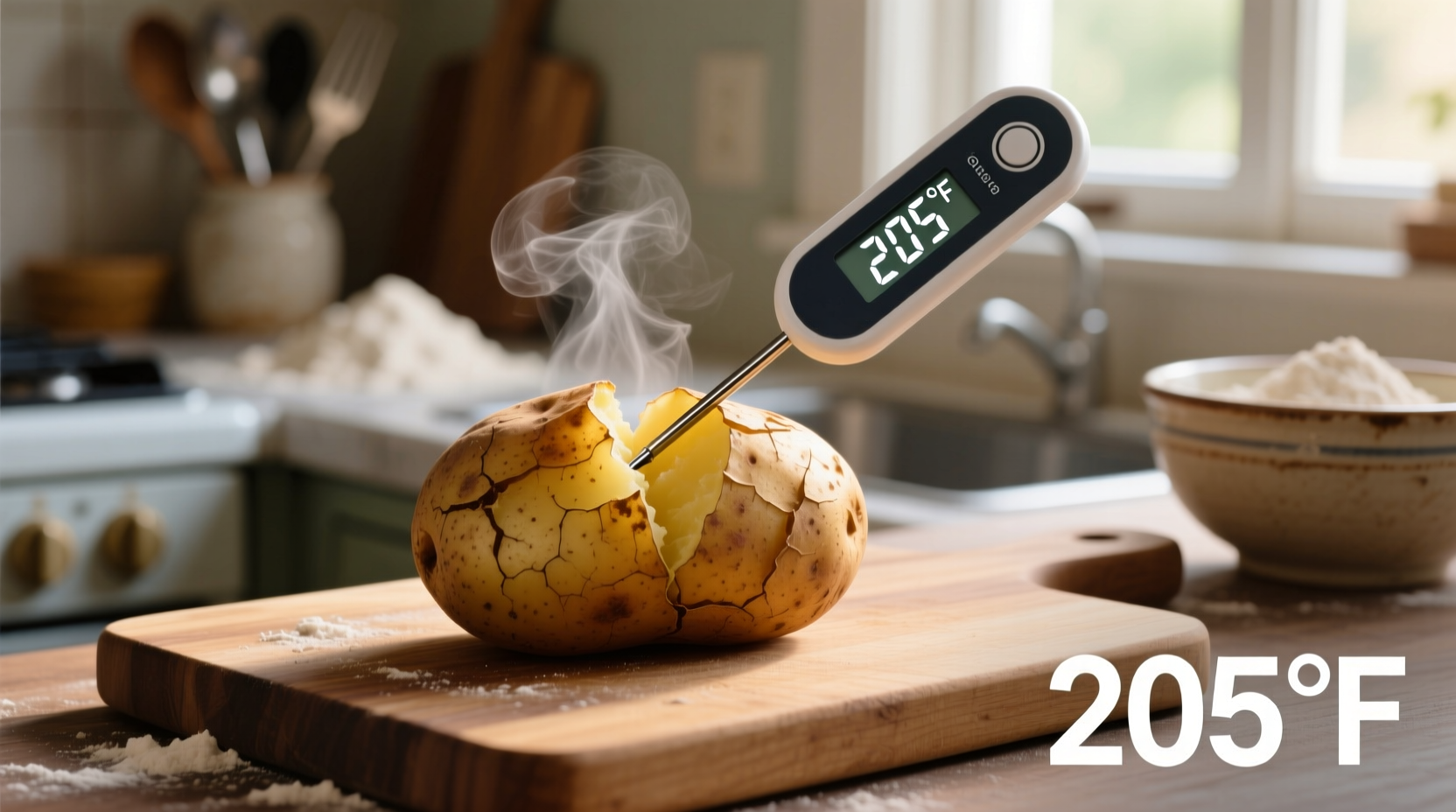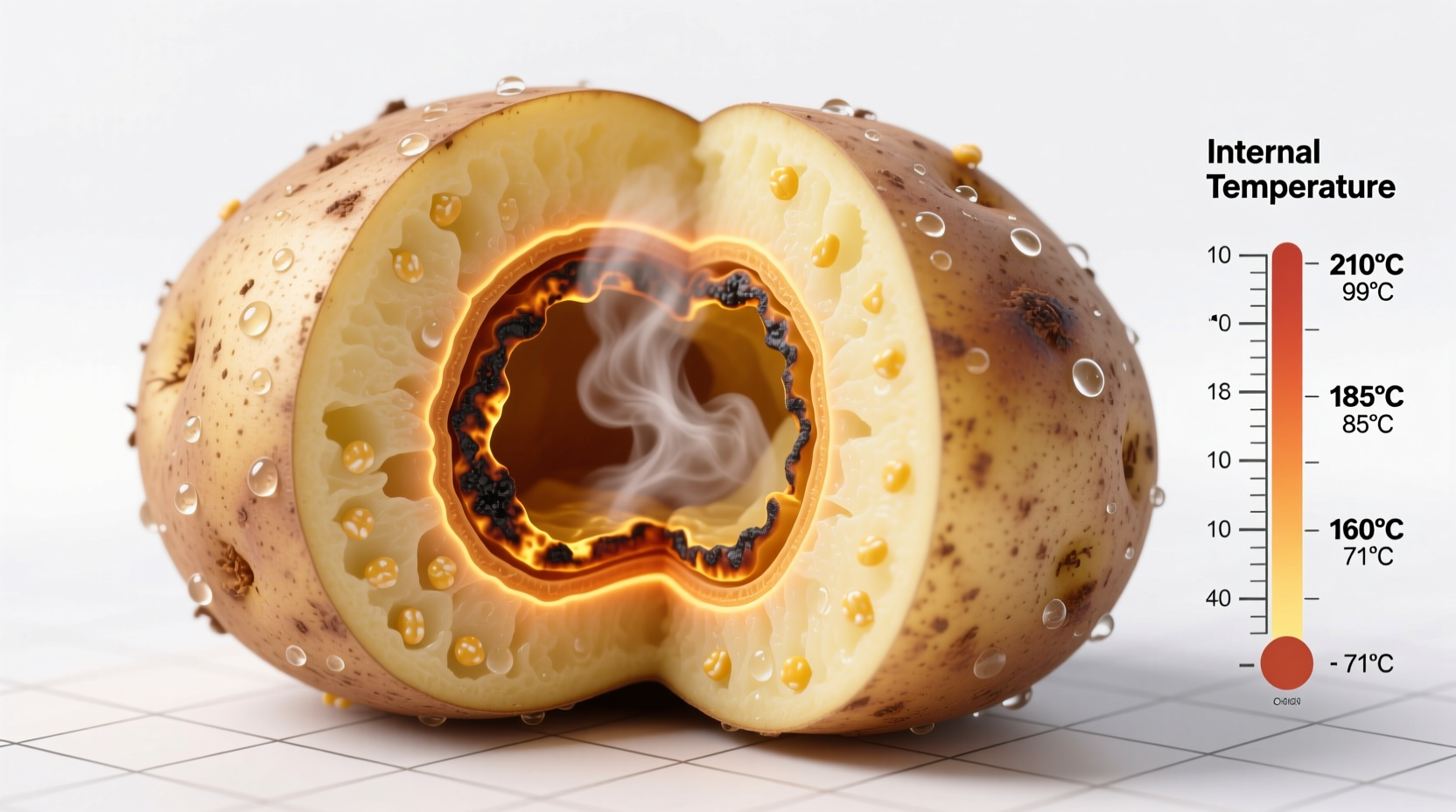Getting the internal temperature of baked potatoes right transforms an ordinary side dish into a culinary triumph. Whether you're a home cook or professional chef, understanding the precise thermal science behind potato preparation ensures consistent results every time. This guide delivers actionable insights based on food science research and professional kitchen standards.
Why Temperature Matters More Than Timing
Unlike timer-based methods, temperature measurement guarantees perfect results regardless of potato size or oven variations. Potatoes reach three critical thermal stages during baking:
| Temperature Range | Starch Transformation | Texture Result |
|---|---|---|
| 160-180°F (71-82°C) | Initial gelatinization begins | Firm, dense texture |
| 190-200°F (88-93°C) | Partial gelatinization | Acceptable but slightly dense |
| 205-210°F (96-99°C) | Complete gelatinization | Perfectly fluffy interior |
This USDA Food Safety and Inspection Service data confirms that potatoes reach safe consumption levels at 200°F, but optimal texture requires slightly higher temperatures. The additional 5-10 degrees makes the critical difference between a serviceable potato and an exceptional one.
Professional Temperature Measurement Techniques
Accurate temperature reading requires proper technique. Insert your instant-read thermometer deep into the potato's center, avoiding contact with the baking sheet or any metal rack. For best results:
- Use a digital probe thermometer with 0.1°F accuracy
- Test multiple spots in larger potatoes (over 10 ounces)
- Wait 10 seconds after insertion for stable reading
- Check potatoes during the final 10 minutes of estimated cooking time

Factors Affecting Baked Potato Temperature
Several variables influence how quickly potatoes reach the ideal internal temperature of 205-210°F:
Potato Variety Differences
Russet potatoes (the classic baking variety) require the full 205-210°F range for optimal fluffiness. Waxy varieties like red potatoes transform at lower temperatures (195-200°F) but won't achieve the same fluffy texture regardless of temperature due to their different starch composition.
Cooking Method Variations
While conventional oven baking remains the standard, alternative methods affect temperature progression:
- Convection ovens: Reach target temperature 15-20% faster due to circulating hot air
- Air fryers: Create crispier skins but require closer monitoring as exteriors can overcook before interiors reach 205°F
- Grill baking: Requires indirect heat placement to prevent exterior charring before interior reaches safe temperature
Troubleshooting Common Temperature Issues
Understanding temperature problems helps correct them for future attempts:
Dense or Gummy Texture Despite Reaching 205°F
This typically indicates rapid cooling after baking. Potatoes continue cooking internally for 5-7 minutes after removal from heat (National Center for Home Food Preservation research shows residual heat can raise internal temperature 5-8 degrees). Allow potatoes to rest wrapped in foil for exactly 5 minutes before serving to complete the cooking process without over-steaming.
Exterior Burning Before Interior Reaches 200°F
This common issue stems from oven temperature inaccuracies. Use an independent oven thermometer to verify actual baking temperature. Most home ovens fluctuate 25-50 degrees from set points. For consistent results, bake at 400°F actual temperature (not set temperature).
Advanced Temperature Techniques for Culinary Excellence
Professional kitchens employ these temperature-focused methods for perfect baked potatoes:
- Pre-bake par-cooking: Microwave potatoes to 180°F before finishing in oven for dramatically reduced baking time
- Temperature mapping: Create a thermal profile by checking temperature every 10 minutes to understand your specific oven's performance
- Carryover cooking calibration: Remove potatoes at 202°F knowing they'll reach 208°F during resting
Remember that altitude affects boiling points and cooking times. At elevations above 3,000 feet, increase target temperature by 2-3°F to compensate for lower atmospheric pressure (USDA altitude cooking guidelines).
Food Safety Temperature Considerations
While 205-210°F delivers optimal texture, food safety requires potatoes to reach at least 200°F (93°C) to eliminate potential pathogens. The CDC's time-temperature chart confirms that holding potatoes at 135°F or above prevents bacterial growth, but initial cooking must surpass 200°F for safety.
Never leave baked potatoes at room temperature for more than two hours. The moist interior creates an ideal environment for Clostridium botulinum growth when cooled improperly. Refrigerate leftovers immediately after the 5-minute resting period.
Conclusion: Mastering Potato Temperature Precision
Understanding and controlling the internal temperature of baked potatoes transforms a simple side dish into a consistently perfect accompaniment. By targeting 205-210°F, using proper measurement techniques, and accounting for variables like potato variety and cooking method, you'll achieve restaurant-quality results at home. The thermometer isn't just a tool for this process—it's your guarantee of perfect texture and food safety every time.











 浙公网安备
33010002000092号
浙公网安备
33010002000092号 浙B2-20120091-4
浙B2-20120091-4